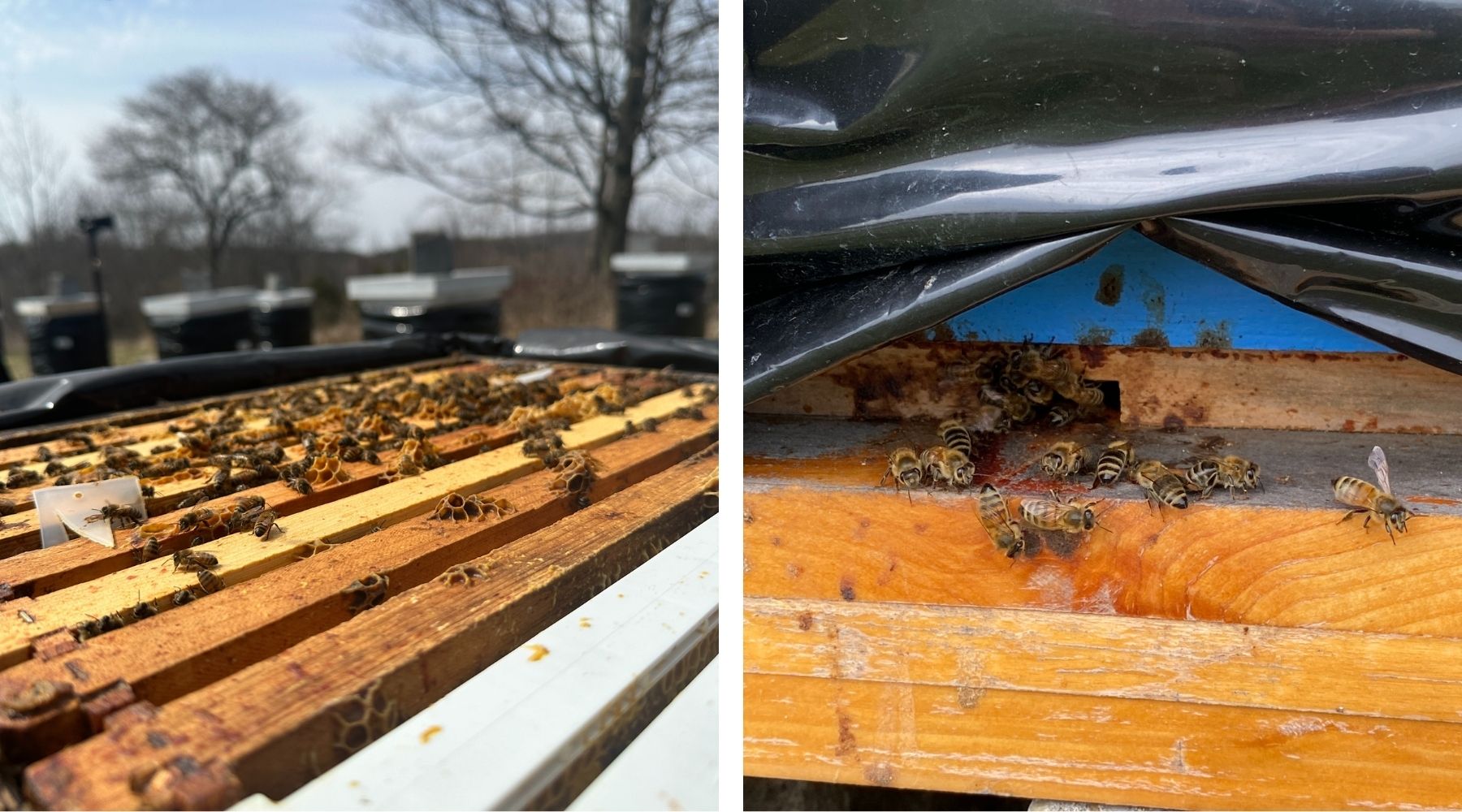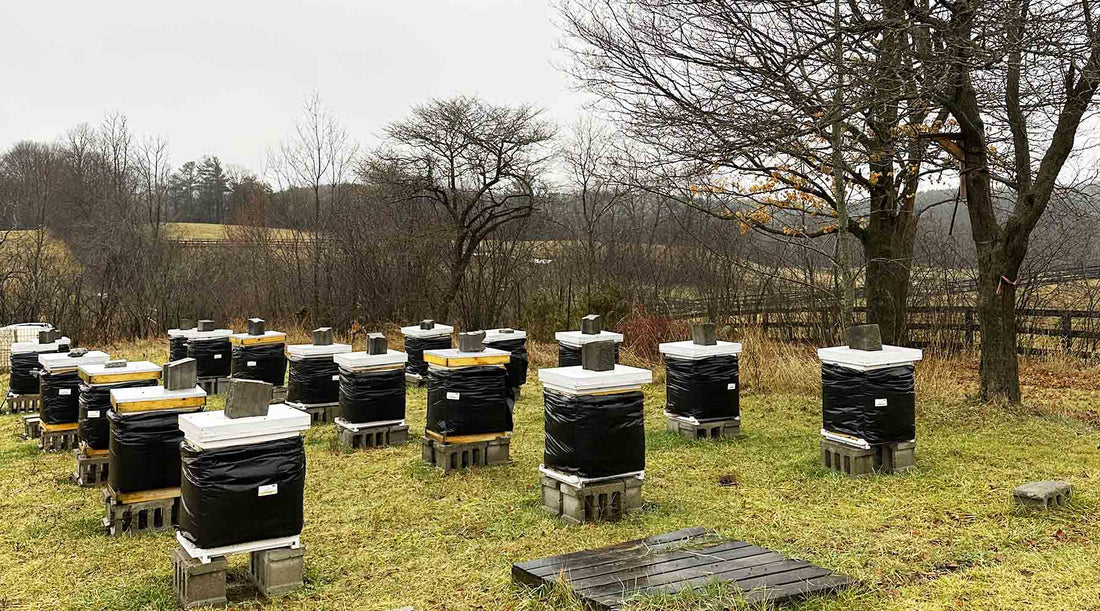Bees can’t forage for food, make honey, or rear their young when the temperature drops. Instead, they hunker down for the coldest months, massing together to stay warm. But the first hints of warm weather mean it’s time to prep the hives for spring. Here are the key steps beekeepers take to set their hives up for good health.
Gearing up
Spring cleaning is top of mind for many as we switch out of winter, and beekeepers are no exception. But where downsizing your wardrobe or degunking your window screens might be your focus, infection control is the name of the game for beekeepers.
To start, most beekeepers take stock of their materials to ensure they’re in good condition. Anything beyond repair is thrown away. From there, they wash any beekeeping suits and veils and heat sterilize hive tools (after scraping off wax and any other substances).
Wooden components like frames can be cleaned by submerging them in boiling water and caustic soda and scorched with a blow torch to sterilize them. The darkening of the wood is a good indication that they’ve been heated to sufficiently high temperatures.
Sterilizing beekeeping gear regularly is an important method of infection control. Even if you cleaned and disinfected all your gear before winter, you’ll want to go through this process again in spring. Continuing to practice regular cleaning and sterilization throughout the season will keep your bees as healthy as possible.
Reusing equipment and purchasing secondhand gear is an integral part of beekeeping. It’s also a great way to save money and meet fellow apiary enthusiasts. However, you should never use equipment that has come into contact with diseased colonies. In some cases equipment can harbour infectious agents long after intense cleaning, spreading disease to new colonies.
Spring feeding
As part of preparing for winter, keepers ensure that their colonies have enough food to last until spring. This means not over-harvesting honey from the hives, or if they do, replacing it with sugar cakes or another easily consumable calorie source for their buzzing buddies.
However, sometimes colonies consume more than expected over the winter. This can result in dangerously depleted food stores come late winter and early spring.
Thankfully, checking on the bees’ food situation is very doable. The trick is simply to remove any weights off the hive and lift it up gently. The weight will indicate whether or not the bees have depleted their food stores. A light hive means supplementary feeding is necessary. A heavy one means it isn’t.
The caveat is that even if your hives feel heavy at the start of February, you’ll want to continue checking them every two to three weeks right through until the end of March. The queen bee starts laying more eggs around this time which means the hive has more mouths to feed.
Since weather is still unpredictable and flowers may not be as plentiful as necessary, the bees can end up without enough food. In fact, bee colonies are most likely to face starvation in February and March.

Scouting for signs of life
The cold weather of late winter and early spring means that hives should stay closed at all costs. The bees inside are clustered together in order to stay warm. Opening up the hive allows too much heat to escape. This can be disastrous for the bees as they’re unlikely to be able to generate enough heat to regain the warmth they need.
Despite this issue, you don’t have to wait for the warm weather to arrive before checking on your colonies.
Bees don’t hibernate during winter. They’re not as active as they are in the warmer months, but still awake and eating inside the hive — which means they also have to go to the bathroom.
Bees are naturally clean creatures, so this poses a bit of a problem for them. To avoid dirtying their home, bees hold in their poop for weeks and sometimes months during the winter. But they can’t hold it forever. As soon as a warm enough day arrives, they embark on cleansing flights.
If your bees are healthy, you’ll be able to spot the signs of various cleansing flights outside the hives. Lots of bee poop around the apiary is a good indication that all is well inside.
Unwrapping the hives
Ontario beekeepers wrap their hives in added insulation to ensure bees stay as toasty as possible over the winter. Once the weather warms up, they must remove this insulation to stop the colonies from heating up too much. But, while the date of the vernal equinox is set in stone, the weather isn’t always as cooperative.
Just like humans, bees have to use more energy to keep themselves warm. Removing hive wraps too early can force the bees to expend precious calories at a time when food is scarce. This can put unnecessary stress on your hives, resulting in higher losses.
To avoid this, don’t let the calendar dictate when to unwrap your hives. Instead, go by the temperature. Since spring nights can get pretty frigid, hives should stay wrapped until nighttime temperatures are consistently above 0°C for two weeks.
Checking for disease
It may seem grim, but for many beekeepers spring means looking for signs of disease. Winter can be rough on bees, and being forced together in a weakened state gives any lurking diseases a chance to spread.
To ensure a colony is healthy, keepers must thoroughly inspect their hives once days and nights are consistently warmer. This involves removing frames to examine the health of the brood that’s been laid. Inconsistent patterns, dead brood, or both, can signal that all is not well.
American foulbrood (AFB) is probably the most famous bee disease, and for good reason. AFB can affect colonies throughout the seasons and its hallmarks are irregular brood pattern, and dark, dead, and mucousy larvae. It also results in a fishy, rotten odour emanating from the beehives.
AFB is highly contagious. As the dead larvae harden, they produce spores. Live bees then spread these spores to other bees and other colonies as they move around.
AFB’s rapid spread and lack of cure means there’s no time to waste once signs of it are spotted. It may sound harsh, but infected colonies must be destroyed immediately upon discovery. Any equipment, honey, wax, or pollen associated with the infected colony must also be destroyed by burning.
While it’s the most severe disease a honey producer can be afflicted with, AFB is thankfully rare in Ontario. Unfortunately, it’s not the only disease Ontario beekeepers worry about. They must also keep an eye out for other diseases like chalkbrood, as well as parasites like Nosema, tracheal mites, small hive beetles, and the often-present varroa mite.
Controlling for pests
Bees can be the victim of several different kinds of pests. Varroa mites are tiny parasites that are almost always present where honey bees are found. Varroa vampirize adult bees. However, their real destructive force is that they lay their eggs on bee larvae and feed off the developing baby bees.
This parasitism causes the baby bees to develop abnormally or die altogether. Varroa lay their eggs on bee larvae before the larval cells are capped, leaving the lifecycle of the mites uninterrupted as they hatch and feed off the baby bees.
Spring is a great time for keepers to look at their hive’s varroa mite populations. The lack (or very low number) of brood means most varroa mites are attached to adult bees instead of capped inside of brood cells. This makes them more susceptible to treatment.
Beekeepers have several different options for treating the mites. Oxalic acid is a favourite method during the brood-free days of spring as it’s both effective and safe for bees. There are also additional options — both chemical and physical — that keepers can pursue if conditions aren’t optimal for this form of treatment.

Looking for the queen
Without the queen bee, nothing in the hive functions the way it should. Consequently, a spring check has to include looking out for the colony’s queen to see what sort of shape she’s in.
If you find the queen bee dead when you open the hive, check to see if any queen cells are present. Usually found on the bottom of a frame, these peanut-shaped pods are used to rear new queens. It’s not a given that you’ll find them, however. Queens don’t typically lay during the coldest months, so there may not be any eggs for workers to raise a new queen.
In this case, beekeepers should requeen the colony by purchasing a new queen and installing her in the hive.
If your queen is alive and well, there’s no need to do anything else. As the weather warms and the days get longer, the queen will increase the number of eggs she lays. At her peak, she can lay between 1500 and 2000 eggs a day, helping to repopulate the colony in no time.
There’s no doubt that spring is a busy time for beekeepers. But putting in the work now helps to ensure that your colonies will flourish over the months to come. A little bit of spring elbow grease means happy and healthy bees and a whole lot of honey coming your way.

